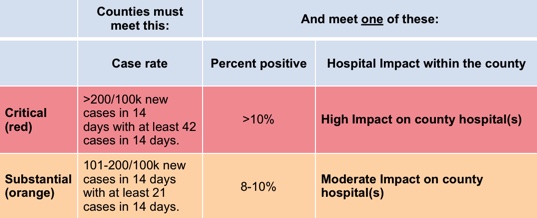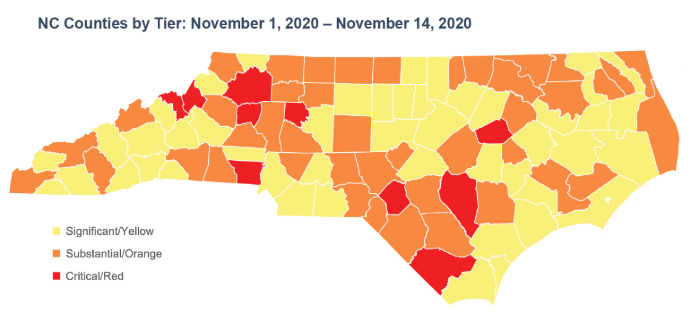With COVID-19 trends worsening across the state, Gov. Roy Cooper is worried.
On Nov. 17, the N.C. Department of Health and Human Services reported 3,288 new cases of COVID-19, the second-highest number of cases reported in a single day. At the same time 1,502 hospitalized COVID-19 patients marked a new state record. The percent of positive tests is up to 8.1% — significantly above the 5% threshold state health officials say represents a controllable level of new infections.
It’s not a surge yet, but heightened viral spread in local communities and across the country should act as a “canary in a coal mine” for what North Carolina could soon be facing, Cooper warned at a Nov. 17 press conference.
In response, state health officials unveiled a new county COVID-19 alert system designed to pinpoint hot spots and offer targeted recommendations to reduce the spread of COVID-19. All 100 counties are assigned a color-coded tier to indicate areas where residents need to ratchet up protective measures, announced Cooper.
The system uses metrics informed by the White House Coronavirus Task Force to place counties into three categories, said Dr. Mandy Cohen, the state’s secretary of health and human services: Yellow, where significant community spread is occurring; orange, with substantial community spread; and red, where viral spread has become critical.

Currently, every North Carolina county is classified at least as yellow due to widespread and sustained viral spread in the community, Cohen explained. The system uses per-capita case rates, the percent of positive tests and a composite hospital score that takes into account hospitalization rates, staffing shortages and emergency room visits to determine a county’s classification.
The alert system also includes additional health recommendations for individuals, business owners and public officials residing in orange and red counties. Suggestions include teleworking when possible, imposing civil penalties to enforce statewide executive orders, instituting limits on in-person community and religious gatherings and opening additional COVID-19 testing sites. Compliance with the recommendations is voluntary, Cooper said, but failure to slow viral spread will result in additional restrictions at the state and county level, he warned.
As of Nov. 17, 43 North Carolina counties are in the orange zone, and 10 counties are red. Buncombe, which reported 329 new COVID-19 cases over the last seven days, currently falls in the yellow zone; Cherokee, Jackson, Madison and Swain counties all fall in the orange zone. Counties will be evaluated and reclassified every four weeks.
“If officials, businesses, community and faith leaders and people who live in these orange and red counties can work with us to take action to bring down their numbers, we can protect our state’s hospital system and save lives,” Cooper said. “This can prevent us from having to move backward.”
In other news
- Dogwood Health Trust’s $1.5 million investment to bolster responses for the 2020 Census has paid off. According to DHT officials, the response rate in Western North Carolina increased by 2.2%, resulting in a likely $18 billion in additional federal funding over the next 10 years.
- Legal Aid of North Carolina is suing state and county officials in Wake County to stop eviction orders that violate state and federal eviction moratoriums. Cooper announced his moratorium through an executive order signed Oct. 28.
- The WNC Bridge Foundation has awarded nearly $4 million in impact grants to 85 local nonprofits focusing on elder care, wellness support and youth development. The foundation expects to begin the next cycle of grant funding in January.






“As COVID-19 metrics worsen, NCDHHS launches county alert system”. Great. Really comforting to know it will be updated monthly. I’d rather be reading “As COVID-19 metrics worsen, NC governor takes action to enforce stricter protocols”. It just seems like someone somewhere should be doing something?